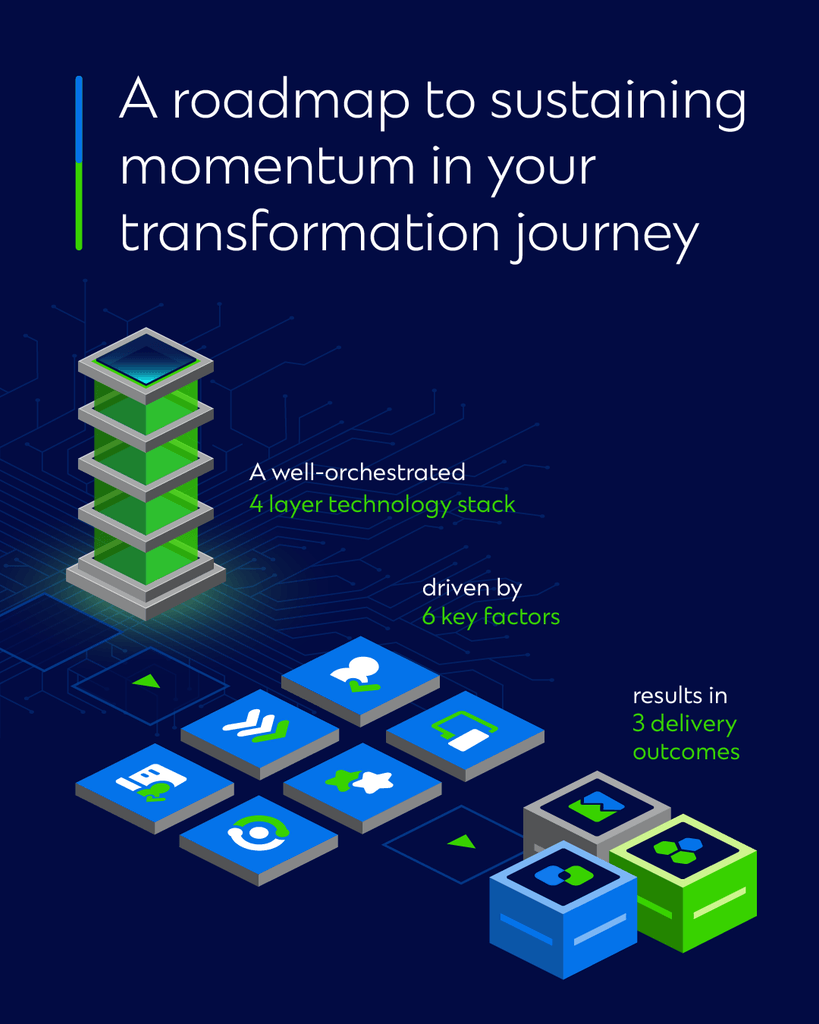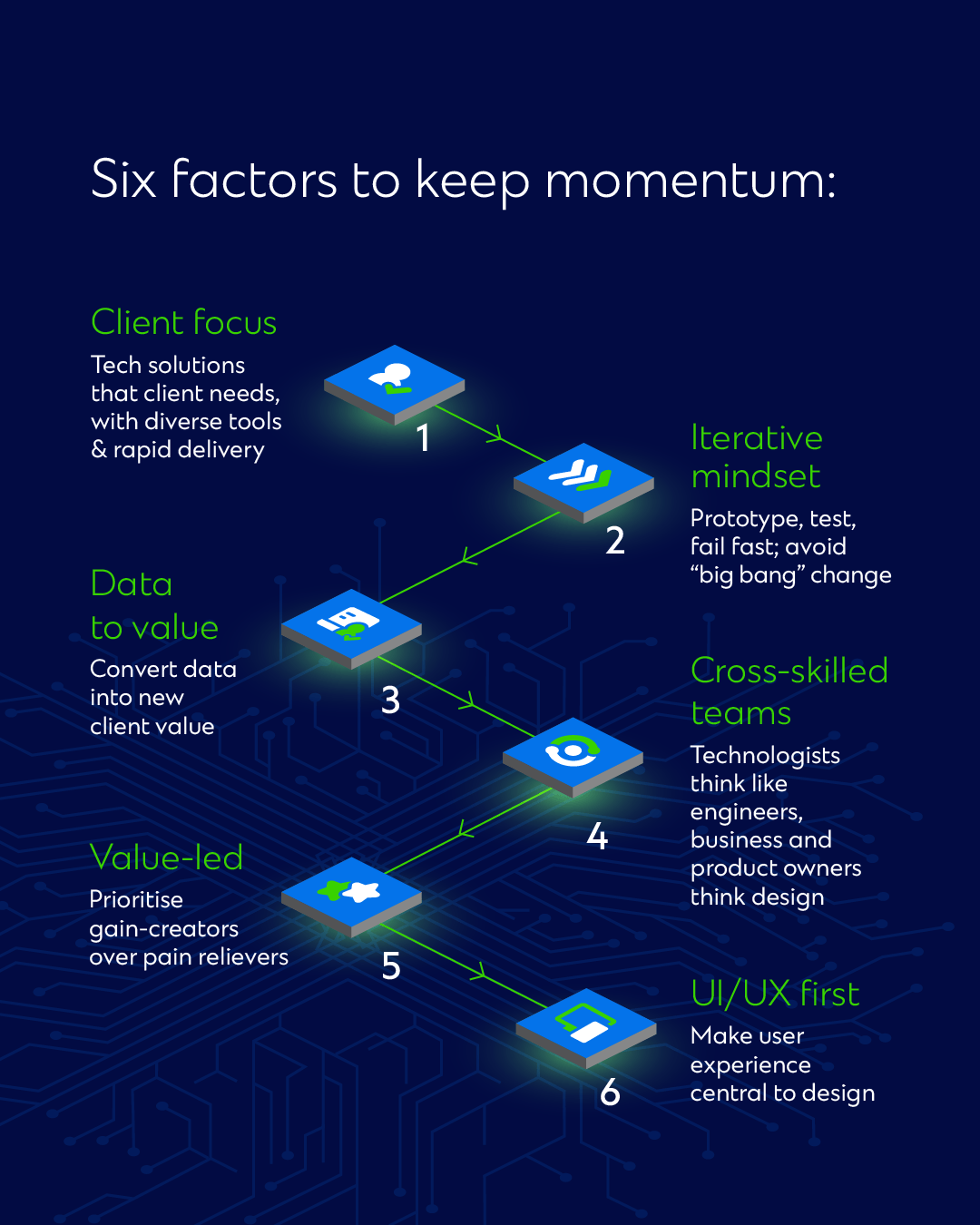A roadmap to sustaining momentum in your transformation journey
We’ve had recent success in transforming operations through tech efficiency. Here’s what worked best.

By using technology to drive efficiency, we have enjoyed some recent successes in transforming our operations.
Take the asset-servicing industry, for instance. Over the past decade, it has developed core processing platforms to create a robust catalogue of standardised central capabilities across large footprints.
While it’s easy enough for organisations to decide that the time is right to update their technology, it’s far less simple deciding quite how to go about doing so. Success means deploying a variety of technologies, and ensuring each plays its role within a well-orchestrated technology stack.
However, in recent years many factors have disrupted the ability of service providers to keep pace with fast-changing local market and regulatory requirements. This has led to an evolution in what a well-orchestrated technology stack is – which, going forward, will comprise of:
- A core processing layer that focuses on standard and scalable processing tasks
- A data layer for the centralisation, modelling and distribution of data to users and processes
- A service layer that enables the data to be used and enriched in a way that is relevant to the business and to transformation
- An AI layer that leverages the core, data and services layers to enable effective predictive and generative AI techniques to identify anomalies and conduct other autonomous forms of processing


By taking this layered approach to technology stacks, organisations will have a better chance of reaching their goal to optimise existing core systems and operating models, while simultaneously improving their ability to adopt emerging technologies that can deliver transformative change, operational efficiencies and new value creation.
Momentum: Six key factors

During our transformation and efficiency drive, we came to realise that six key factors were essential to maintaining momentum. They cut across the client and user experience to include areas like design, data and technology.
The first was client focus. What do we mean by that? Too often, teams look to reshape the client’s requirements to fit whatever technology is already in the mix. We inverted that idea – we delivered a tech-driven solution our clients need by making available a diverse toolkit of tech capabilities with fast speed-to-market. This was possible only by having the right foundations and build-speed to achieve it. One example of this is our ability to deliver data via API: Although API usage is becoming more of an industry standard, many service providers often pigeonhole their clients’ requirements into predefined, often outdated, API offerings. By leveraging our data layer, we made it possible to deliver faster, more relevant API deployments.
A second factor, therefore, was an iterative mindset. Being iterative means developing prototypes and minimal viable products (MVPs), and failing fast, as opposed to the “Big Bang” change mentality of the past. However, such an iterative approach must be rewarded by senior management and programme sponsors and owners, rather than punishing the inevitable (but valuable) failures that are part of the process. That means revising those legacy KPIs and success measures that no longer align with an iterative mindset.
We also learned it was crucial to understand that a data strategy is only half the journey. Business owners and process owners must convert the data into new value for clients rather than simply using data and services to replicate what was already being done, or only to alleviate pain-points derived from old ways of working.
Momentum was further added by encouraging technologists to be engineers, and business and product owners to be designers. Over the years, the focus on backend, tech-defined automations saw technical business analysts take over business process design and, in turn, product design – a trend that often resulted in inflexible technology builds. By shifting to creating scalable, reusable and foundational services, business and product owners could in turn play a larger role in design, and deploy product features more relevant to user and client needs.
The fifth lesson learned was to prioritise business use cases that are gain-creators, not just pain relievers. Granted, pain relievers can provide earlier stage, but smaller, wins, which are important. However, true transformative value comes from processes or operating models that perhaps don’t yet exist. It is this transformative value from “gain creation” that results in a force multiplier effect of productivity improvements. This shifts improvements from the typical 0-100 per cent range to a far greater multiplier range of 5-10x (or 500-1,000 per cent).
We also found that focusing on pain relief often perpetuates the development of like-for-like solutions, delivering the use case to specification, but falling short of creating sustainable business and client value.
Our final lesson was that the user interface and user experience (UI/UX) must be major components of the design phase. Although automation itself is important, robust UI/UX is the key to adoption and scalability, especially for large-scale transformative change. We recognised that once we had solved our data and automation challenges, the remaining friction and bottlenecks to sustainable transformative change was to ensure that business processes were accessible and manageable by users in a user-friendly manner.
Taking an example of an industry-first natural language processing (NLP) AI solution we rolled out in 2023, and the push for business/product owners to be designers, we were also able to solve for continuous AI model improvements through a UI/UX solution. This involved automatically feeding manual inputs back into the model to continuously train and improve it (a technique called reinforcement learning with human feedback, or RLHF). This UI/UX design consideration ensured additional efforts were not added to the user’s tasks, but rather took what users already did to solve seamlessly for another need.
Revamp the stack: Delivering foundational capabilities
These six factors proved vital to sustaining our momentum throughout the lengthy process – a process that saw us revamp our technology stack. When we consider the results, several aspects stand out.
The first is that our investments into foundational data platforms have enabled new offerings (such as the operational management of digital assets) and enhanced existing products – providing the opportunity to reap incremental benefits.
Second, we continue to implement emerging technologies with an “integration first” focus, which ensures they are seamlessly adopted into existing workflow platforms. The NLP example mentioned earlier means Standard Chartered now uses advanced NLP and RLHF techniques in our top 14 markets, both for settlements and corporate actions processing – which was done through the seamless integration into existing workflow platforms. This approach ensured no disruption to business-as-usual activity, while leveraging an advanced AI solution to augment processing time and service quality for direct client benefit.
Third, we maximised the strengths of our core platforms. By doing that, and by bringing incremental features into our data, service and AI layers, we have kept the core stable and focused on standard capabilities and offerings – while addressing the more bespoke, complex and nuanced requirements in the outer layers. This multi-faceted approach has enabled Standard Chartered to accelerate our ability to lead the industry in keeping pace both with disruption, such as compressing settlement cycles, and evolving client needs, especially for data insights and the incorporation of AI.
This approach has seen us define a component-based ecosystem that drives seamless integration. In this way, we have optimised our already-robust operating model while maintaining an industry lead in a period of profound technological change.

More insights
Fueling growth and deepening ties
We reinforce our partnership with San Miguel Corporation Group through the facilitation of BankCom’s largest bon…